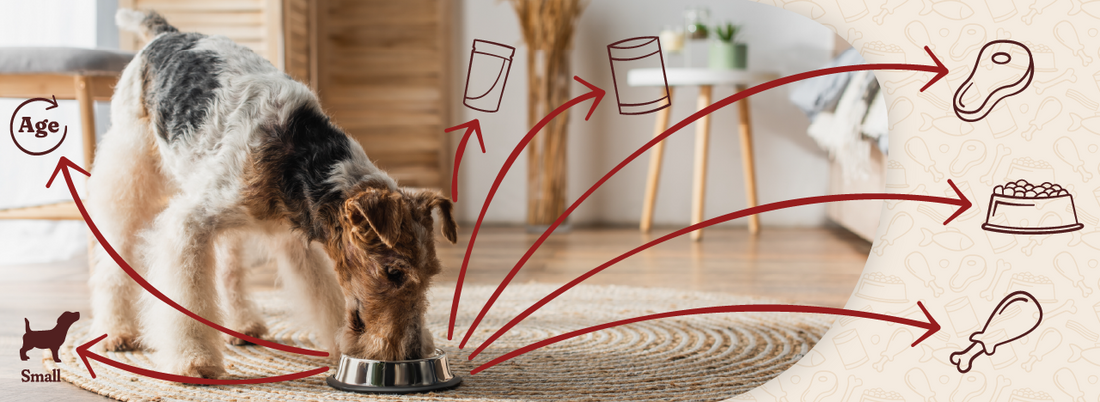
How to Choose the Right Dog Food
Share
I remember when we picked up our two (yes, two) Rat Terriers for the first time. Gone are the days of quiet mornings with a warm cup of coffee—those have been replaced by squeaky toys and dog chatter echoing down the hallway.
Having both dogs, we’ve seen opposite ends of the food spectrum. Zeke is our picky eater. Cass? He’ll devour anything you put in front of him, tail wagging the whole time. Finding the right food for Zeke has been a real challenge—too dry, too wet, wrong size, not tasty enough. He keeps us on our toes.
The Pet Store Aisle That Changed Everything
I still remember walking down the aisle of our local pet store, overwhelmed by the endless rows of dog food. Kibble, cans, raw diets—so many labels, so much confusion. I left the aisle with more squeaky toys than answers.
That's when I decided more research was needed.
Why Popular Doesn’t Always Mean Best
Choosing dog food shouldn’t be based on popularity. Much like us, dogs need consistent, bioavailable nutrients to stay active, strong, and healthy. What works for one dog may not work for another.
In this guide, we’ll break down:
-
How breed and size affect food needs
-
Why age matters
-
Whether dry, wet, or raw is right for your dog
-
How to read dog food labels without getting duped
Breed & Size Matter—A Lot
Between our 210 lb. English Mastiff, Tucker, and our 15 lb. Rat Terriers, we’ve seen it all. The size of the kibble matters. Smaller dogs need small kibble to avoid choking, while large breeds need appropriately sized food they can chew safely.
And it’s not just about size—breed-specific issues play a big role too. For example, giant breeds like Tucker are prone to joint issues and benefit from foods rich in:
-
Omega-3 fatty acids (like salmon)
-
Glucosamine and chondroitin
-
Anti-inflammatory ingredients like turmeric or functional mushrooms
Looking for joint-supportive nutrients? Our dog food topper includes whole food ingredients designed to support mobility and overall vitality.
Age-Specific Nutrition
Whether they’re bouncing puppies, active adults, or slow-moving seniors, dogs need age-appropriate nutrients.
Puppies
Puppies burn a ton of energy and require:
-
More calories
-
Smaller kibble
-
Higher levels of protein and fat
As they grow, their diet must gradually transition to adult formulas to prevent overfeeding or undernourishment.
Adult Dogs
Adult dogs need a maintenance-level diet rich in protein, fiber, and healthy fats. Look for formulas that include:
-
Digestive support (like inulin and postbiotics)
-
Moderate calories
-
Joint support for active lifestyles
Senior Dogs
Senior pups often slow down and become more prone to:
-
Weight gain
-
Joint stiffness
-
Digestive issues
-
Cognitive decline
Choose foods with:
-
Lower calories
-
Added fiber
-
Joint-supporting nutrients
Dry, Wet, Raw—or All Three?
Dry Food (Kibble)
Most common, cost-effective, easy to store—but be cautious. Many brands include fillers, preservatives, and artificial ingredients.
Tip: Look for products with whole food ingredients at the top of the ingredient list.
Wet Food
Wet food is:
-
Easier to chew
-
Often more palatable
-
Higher in moisture (good for hydration)
-
Ideal for senior dogs or those with dental issues
However, it’s more expensive and can spoil quickly after opening.
Raw Diet
A raw diet mimics what dogs might eat in the wild: meats, organs, bones, and vegetables. Benefits may include:
-
Increased energy
-
Healthier coat and skin
-
Fewer additives
Important: Raw diets require careful handling to avoid bacterial contamination. If homemade, ensure your dog is still getting complete nutrition. Learn more from Dogs Naturally Magazine.
Understanding Dog Food Labels
Dog food labels can be misleading—here’s how to read them.
What “With” Really Means
When a label says “with beef,” it only needs to contain 3% beef. That’s just 0.75 lbs in a 25 lb bag.
-
“Chicken and Beef”: must contain 3% of each
-
“Beef Flavor”: just enough to taste like beef, not necessarily include it
Ingredient Order
Ingredients are listed by weight. That’s why you want to see whole foods or meat proteins listed first—not “corn gluten meal” or “meat by-products.”
Tip: If you can’t pronounce the ingredients, it’s probably not something your dog should eat.
"Complete and Balanced"
This phrase indicates the food contains all essential nutrients in appropriate ratios. According to the FDA’s pet food guidelines, this is one of the most meaningful claims to look for.
Final Thoughts: Know Your Dog, Not Just the Label
Choosing the right food isn’t about grabbing the prettiest bag—it’s about understanding your dog’s specific needs and making informed choices.
-
Read labels carefully
-
Look for quality ingredients, not fillers
-
Choose age- and breed-appropriate formulas
-
When in doubt, consult your vet
By staying attentive and making intentional choices, you’re not just feeding your dog—you’re improving their quality of life.
Explore Ancient Paws’ ingredient philosophy and see how food-first nutrition can help your dog thrive.






